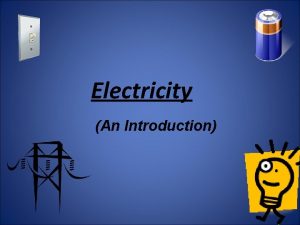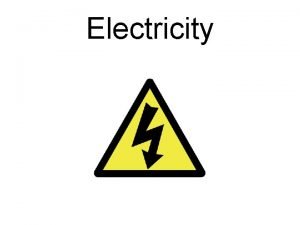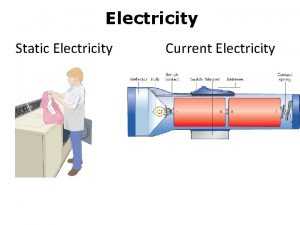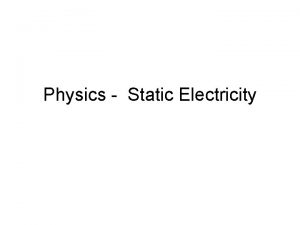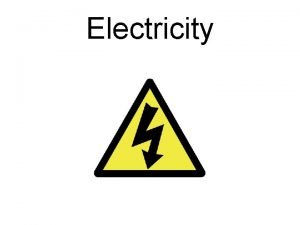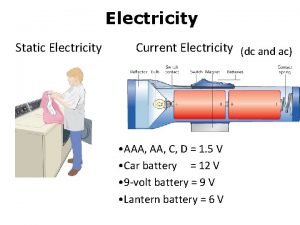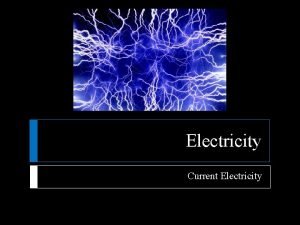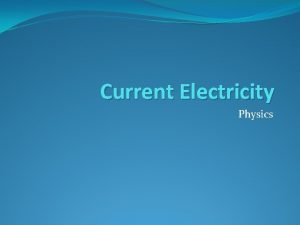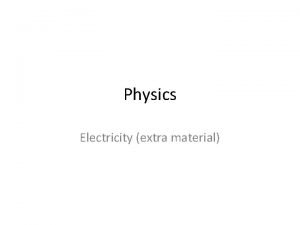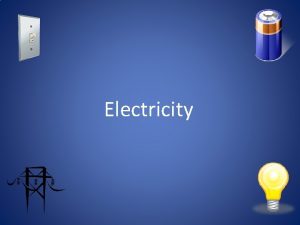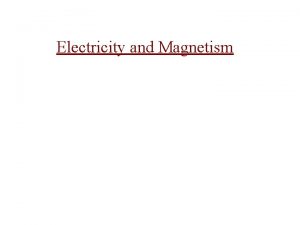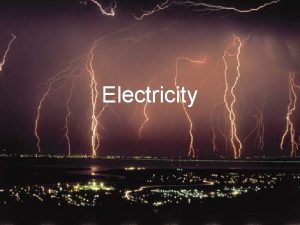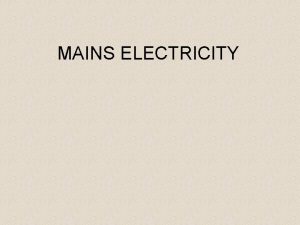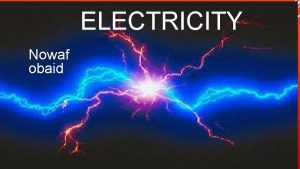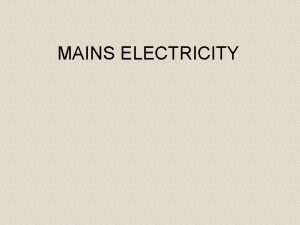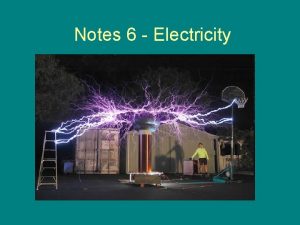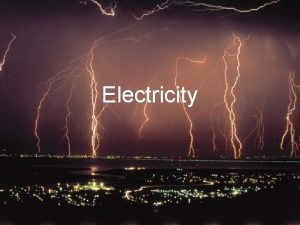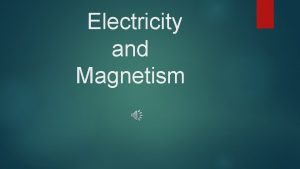Introduction to Electricity Part II The Changing Electricity

























- Slides: 25

Introduction to Electricity Part II: The Changing Electricity Industry

The Electricity Industry Electricity systems worldwide are changing for one or more reasons: Technological advances Financial/management crisis/inadequate investment Public opposition Consumer demand for lower costs, better service Political cronyism. . .

Vertically Integrated Model Energy & Finance Ministry UTILITY Generation UTILITY Transmission UTILITY Distribution Residential Industrial Commercial

The Changing Industry Structure Vertically Integrated Model – generation, transmission and distribution controlled by one or several utilities (usually state owned). Government grants utility monopoly power Regulated by government Centralized planning, operation Government-guaranteed investment/regulator ensures cost recovery from consumers Captive consumers/ratepayers Key problems: high cost AND/OR low quality service

Single Buyer Model Government Regulator State Owned Power Plants Private – Independent Power Producers IPP UTILITY National Transmission System Owner/Operator UTILITY Distribution Municipal or Provincial Industrial/Rural Cogeneration Small/Renewable Power Producers Consumers/ Small Producers

The Changing Electric Industry Structure Single Buyer Model Private and state producers selling to central utility/no competition Centralized planning, operation Transmission centrally owned/operated by central utility Large industrial consumers can buy electricity from central utility or direct from private power producers or self-generate Key Problems: Small consumers still captive/no choice Government still conflicted as owner/regulator Central utility can shut out competitors NOTE: World Bank promotes this model in China, Thailand, Vietnam but its own experts admit it encourages over-investment, corruption, highcost power purchase deals, poor regulation.

The Changing Electricity Industry Market-Oriented Restructuring: Privatization and unbundling of Generation, Transmission, Distribution New competitive procedures for power producers New forms of regulation

Restructuring Theory/Objectives To raise capital To improve regulation To eliminate government/investor conflict of interest To boost economic efficiency To lower rates and improve service To give producers and consumers competitive choices.

General components of market-oriented restructuring WHICH ONES CAN YOU IDENTIFY IN YOUR COUNTRY? CAN YOU SAY WHICH TRENDS ARE POSITIVE FOR CONSUMERS? WHY? 1. Unbundling of generation, transmission, and distribution into separate businesses. 2. Open transmission access. 3. Operation of the transmission system assigned to a few distinct organizations. 4. Creation of a new class of non-regulated generators. 5. Formation of new organizations for dispatch of all generation. 6 Competition in power production with dispatch based on quoted prices. 7 Construction of many gas-fired plants by independent owners. 8. Payments for some power production based on ‘market clearing’ price, which is the highest of any accepted bid prices. 9. Retail “wheeling” increasing in stages to smaller and smaller size customers (unsuccessful in many places). 11. No central planning, no government guarantees to purchasers. 12. Hedging contracts to guarantee prices to power purchasers in a volatile market.

Competitive Market Model Policy Laws Regs POWER PRODUCERs State/Private Industry Regulatory Authority ENFORCEMENT COMPETITION T&D Rates BUY/SELL Electricity Market Operator TRANSMISSION PROVIDERs State/Private DISTRIBUTION Companies/ Rural Energy Cooperatives Investors CONSUMERs CHOOSE SUPPLIERs DISPA Indepe TCH nde System nt Opera tor

Multiple producers Rice husk cogeneration Industrial cogeneration Reduced demand on central grid

Distribution companies Can buy power from supplier of their choice or from market exchange Consumers can sell direct to distribution companies

Old vs New utility regulation Old regulated utilities make money building new power supply projects, bigger=more revenue/profit New regulated utilities help customers save energy; help customers buy less of utility product: electricity!

New utility regulation Utilities earn a return for investment in saving energy that is equivalent to what they earn from investments in new power supply capacity. More state funding for energy efficiency improvements across sectors Governments allow utilities to collect money from ratepayers to pay for energy efficiency projects State-led emission reduction targets

Examples California – Pacific Gas & Electric Co. helping Subway (30, 000 restaurants) install energy-efficient breadbaking ovens Working with wineries – 2, 600 wineries consume one -third of energy consumed by food processors In California, state law requires utilities to meet new supply needs first through energy efficiency then renewables, then building new (conventional) power plants Utilities in California – rate structure rewards them for cutting electricity use, not for pushing energy sales

New Utility Business - Conservation Iowa Power & Light – advising pig farmers on energy-efficient lighting and ventilation – energy-efficient lighting can save $10, 000 a year in electricity cost Pinnacle West Capital – Arizona utility – is working with district school board to install new efficient heating and cooling systems in schools, adding solar to school rooftops


Consumers as Producers Homeowners install ~ 10 k. W solar system Send surplus to the grid and get paid by utility Utilities (Sacramento Municipal Utility) willing to pay retail rate because solar systems produce power during peak (mid-day) hours, improve performance and reliability of grid. 19 states give homeowners credit to reduce their bill, but not cash 10 states require utilities to pay homeowners wholesale rate for surplus solar

Which policy leads to most solar at lower cost? Still too early to tell Critics say solar homeowners are getting a free ride: They get a cash rebate for installing system, which comes from ratepayers They get credit at retail rate even though they don’t pay any transmission maintenance charge Interconnection charge is waived while other producers have to pay >> critics say unfair subsidy Critics say paying people for “surplus” will encourage larger-than-necessary systems (See Thai solar producers)

Examples Duke Energy (North Carolina) – helping Budweiser make its beer chillers more efficient, saving Bud big $ Duke looking to regulator to get special incentives to expand energy efficiency business

Electricity Reform in the Mekong Region

What’s the Future of Big Hydro?

What’s the Future of Coal and Nuclear Power?

What role environmental/community advocates in the Mekong region? System is changing, for better or worse Know your power Bright ideas vs dim bulb policies Define public interest Transparency Accountability Participation Democratize the grid!

END: Introduction to Electricity Part 2: The Changing Electricity Industry
 Static electricity and current electricity
Static electricity and current electricity Current electricity gif
Current electricity gif Electricity and magnetism vocabulary
Electricity and magnetism vocabulary Hát kết hợp bộ gõ cơ thể
Hát kết hợp bộ gõ cơ thể Ng-html
Ng-html Bổ thể
Bổ thể Tỉ lệ cơ thể trẻ em
Tỉ lệ cơ thể trẻ em Gấu đi như thế nào
Gấu đi như thế nào Chụp tư thế worms-breton
Chụp tư thế worms-breton Hát lên người ơi
Hát lên người ơi Môn thể thao bắt đầu bằng chữ đua
Môn thể thao bắt đầu bằng chữ đua Thế nào là hệ số cao nhất
Thế nào là hệ số cao nhất Các châu lục và đại dương trên thế giới
Các châu lục và đại dương trên thế giới Công của trọng lực
Công của trọng lực Trời xanh đây là của chúng ta thể thơ
Trời xanh đây là của chúng ta thể thơ Mật thư anh em như thể tay chân
Mật thư anh em như thể tay chân 101012 bằng
101012 bằng độ dài liên kết
độ dài liên kết Các châu lục và đại dương trên thế giới
Các châu lục và đại dương trên thế giới Thơ thất ngôn tứ tuyệt đường luật
Thơ thất ngôn tứ tuyệt đường luật Quá trình desamine hóa có thể tạo ra
Quá trình desamine hóa có thể tạo ra Một số thể thơ truyền thống
Một số thể thơ truyền thống Cái miệng nó xinh thế
Cái miệng nó xinh thế Vẽ hình chiếu vuông góc của vật thể sau
Vẽ hình chiếu vuông góc của vật thể sau Nguyên nhân của sự mỏi cơ sinh 8
Nguyên nhân của sự mỏi cơ sinh 8 đặc điểm cơ thể của người tối cổ
đặc điểm cơ thể của người tối cổ


























